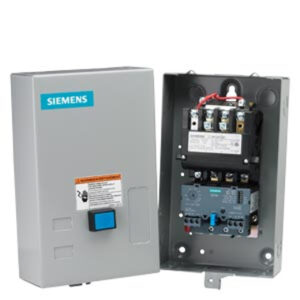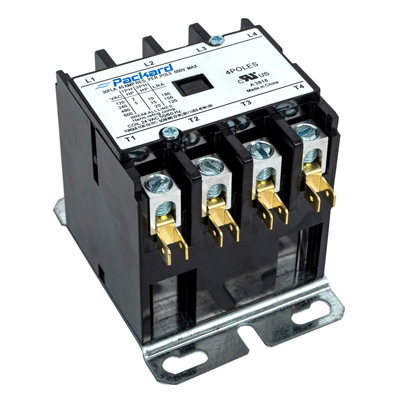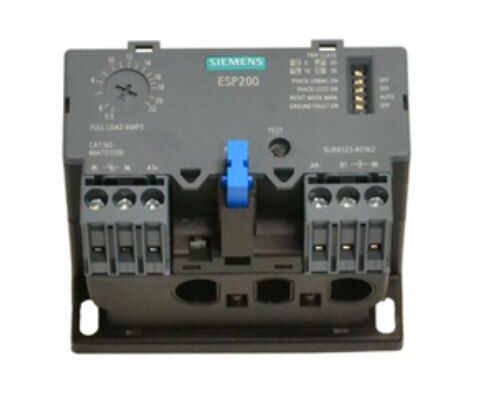Understanding Motor Controls: Starters, Contactors, Overloads, and Disconnects
Starters:
Motor starters control the starting and stopping of electric motors while offering built-in protection features.
Importance of Starters:
- Soft Start Options: Some starters reduce inrush current, preventing electrical and mechanical damage.
- Remote & Automated Control: Allows for safer and more convenient motor operation.
- Integrated Protection: Most starters include overload protection to prevent overheating and excessive current draw.
Types of Starters:
- Combination Starters: Include a contactor, overload relay, and disconnect switch, simplifying installation and ensuring NEC compliance.
- Non-Combination Starters: Only contain a contactor and overload relay, requiring an external disconnect switch or breaker.
Example Application: Combination starters are commonly used in industrial HVAC systems, where integrated safety and compliance are required.
Siemens 14CUB32BA NEMA Size 0 NEMA 1 Enclosure Motor Starter
Contactors
Contactors are electromechanical switches that control power flow to motors, lighting, and industrial equipment.
Importance of Contactors:
- Handles High Currents: Designed to switch large electrical loads efficiently.
- Remote Operation: Enables control from a panel or automation system, improving safety and efficiency.
- Fail-Safe Designs: Many contactors have safety features, such as arc suppression and interlocking mechanisms, to prevent unintended activation.
Types of Contactors:
- 3-Pole Contactors: Standard for three-phase motors, used in most industrial applications.
- 4-Pole Contactors: Include an extra pole to switch the neutral wire, useful in backup power and generator transfer systems.
- 2-Pole Contactors: Used for single-phase motors, such as in HVAC compressor control.
- Reversing Contactors: Allow a motor to change direction by swapping phase connections.
- Vacuum Contactors: Used in high-voltage applications, offering superior arc suppression.
- DC Contactors: Designed for battery-powered equipment, such as electric vehicles and renewable energy systems.
Example: A 4-pole contactor is commonly used in standby power systems, ensuring that both phase and neutral are disconnected when switching between power sources.
Packard C440C 40 Amps 208/240 Coil Voltage 4 Pole Contactor
Overloads
Overload relays protect motors from excessive current by monitoring electrical load conditions and shutting down the circuit when necessary.
Importance of Overloads:
- Motor Protection: Prevents overheating and potential motor burnout.
- Adjustable Settings: Allows customization based on motor size and operating conditions.
- Safety Compliance: Ensures adherence to NFPA 70 (NEC) and IEC motor protection standards.
Types of Overload Protection:
- Thermal Overload Relays: Use bimetallic strips to detect excessive heat buildup.
- Electronic Overload Relays: Provide digital monitoring for precise protection.
- Magnetic Overload Relays: React to sudden high-current spikes, often integrated with circuit breakers.
Example: In a pump control system, an electronic overload relay prevents damage if the pump gets blocked and starts drawing excessive current.
Siemens 48ATC3S00 ESP200 Solid State Overload Relay
Disconnects
A disconnect switch provides a manual way to isolate electrical circuits for maintenance or safety compliance.
Importance of Disconnects:
- Ensures Safe Maintenance: Prevents accidental re-energization of equipment.
- Code Compliance: Required by OSHA and NEC regulations for industrial electrical systems.
- Reliable Isolation: Helps prevent electrical hazards during repairs.
Types of Disconnect Switches:
- Fused Disconnects: Provide both isolation and overcurrent protection.
- Non-Fused Disconnects: Used where a separate circuit breaker or fuse provides protection.
- Enclosed Disconnects: Designed for harsh environments with NEMA-rated enclosures.
Example: A disconnect switch is required in manufacturing plants to isolate conveyor motors for maintenance, preventing accidental restarts.
How These Components Work Together in a System
These four components form the foundation of an industrial motor control system. Here’s how they work together:
- Starting the Motor: The operator activates the starter, energizing the contactor, which allows power to flow to the motor.
- Monitoring and Protecting the Motor: The overload relay continuously monitors current. If excessive current is detected, the overload relay trips the circuit, stopping the motor before damage occurs.
- Isolating Power for Maintenance: Before maintenance, the disconnect switch is used to completely cut power to the motor and control circuit. This ensures safe servicing and compliance with electrical safety regulations.
Conclusion
Understanding the role of starters, contactors, overloads, and disconnects is essential for industrial operators, electricians, and engineers. By selecting and integrating these components correctly, facilities can ensure:
- Safe operation of motors and electrical systems.
- Reduced downtime through proper overload protection.
- Compliance with standards.
By implementing the right motor control solutions, businesses can enhance efficiency, extend equipment life, and minimize operational risks.



